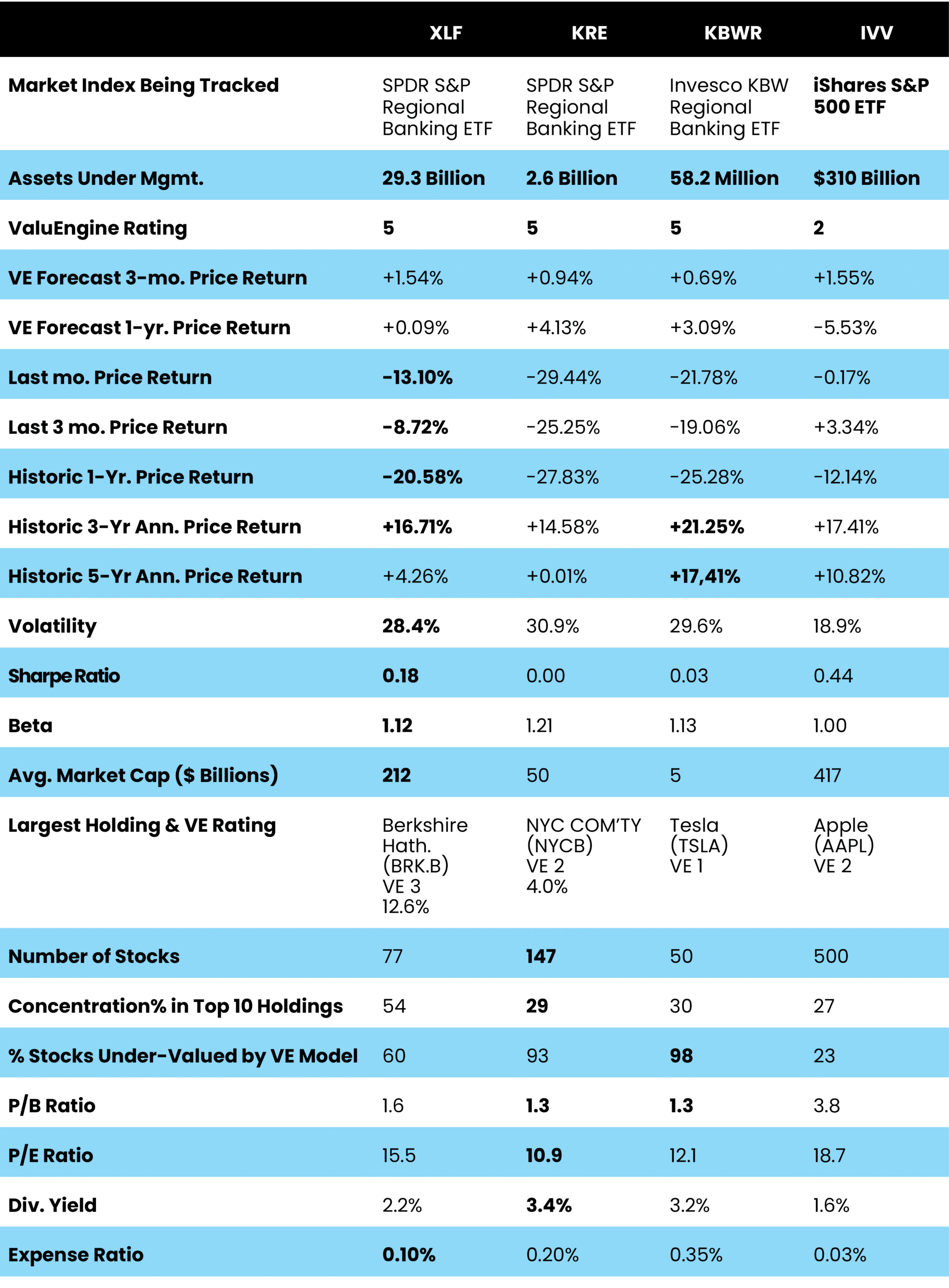The editor-in-chief of well-respected ETF Stream, Tom Eckett, published a rare editorial March 24 saying the big selloff in bank stocks resulting from fear of a contagion in the industry was close to over. He said bank ETFs were at rarely seen low levels compared with earnings expectations, which should not be thrown off too much by the so-called crisis caused by half a dozen bad actors. He especially prefers ETFs to bank stocks in this situation because there is safety in numbers; even if one or more bad actors are found, an ETF won’t be hurt that much.
In this article, I consult the Value Engine’s predictive model on bank ETFs and their top holdings. For a change, I’ll give the answer to the title question ahead of the analysis. The predictive and valuation models both agree with Tom. The momentum against banks shows signs of settling and no longer resembles a falling knife. The stocks of strong banks with high earnings expectations are now selling at what our valuation model considers bargain prices. So yes, if you are an active or semi-active investor, you may wish to consider bank ETFs and bank stocks now.
This development should be of interest to conservative income and value investors. Many ETFs represented as income opportunities in the past few years have also resulted in destruction of capital. Bank ETFs now have above-average dividend yields and very attractive valuation ratios. Their beaten-down stocks should rebound before too long, even though no one knows exactly when. The point here is that the majority of older regional banks have conservative balance sheets and strong reserves. There has been a lot of bank balance sheet scrutiny as a result of the collapse of Silicon Valley Bank. Both the Fed and the large investment houses went deep into the statements before being satisfied that the U.S. banking system was not in contagion. The industry is such that we will always have experts shouting alarms. However, predictions of Armageddon-type events are usually wrong. Older investors, particularly, may find a number of potential opportunities with strong income streams from banks that seem almost certain to bounce back eventually.
The three ETFs in this analysis are:
XLF: Financials Select Sector SPDR Fund. XLF offers efficient exposure to the heavyweights in the U.S. financials segment. Its cap-weighted, S&P 500-only portfolio means that it’s concentrated in large banks and avoids small caps.
KRE: SPDR S&P Regional Banking ETF. KRE covers the regional banks segment of the S&P Total Market Index, an index that tracks the broad U.S. equity market. Companies that meet certain market-cap and liquidity requirements will be included in the fund’s final holdings. Selected securities are then equally weighted, subject to liquidity constraints. Overall, KRE’s equal-weighting scheme reduces single-stock risk in the smaller names and helps to draw further distinctions from peers with big positions in large-cap names.
KBWR: Invesco KBW Regional Banking ETF. KBWR doesn’t attempt to provide broad exposure to the U.S. banking segment. Instead, the fund employs an index committee selection process, along with modified market-cap weighting to construct a portfolio of regional banking and thrift firms. This process makes an already small-cap-oriented portfolio tilt even smaller. In fact, KBWR’s portfolio has one of the smallest average market caps in the segment. The fund’s scope does not stray from its narrow mandate. It provides the exact exposure it promises, with no industry tilts.
This trio provides very different choices for potential investors that look under their hoods. XLF is simply a cap-weighted slice of banks, credit issuers, and insurance companies that are in the S&P 500 Index. It includes Berkshire Hathaway, JP Morgan Chase, Goldman Sachs, Mastercard Int’l., Citi, etc. KRE focuses on regional banks in an index that includes mid-cap and small-cap stocks and is equally weighted. New York Community and Citizens are its largest holdings. KBWR uses a committee to make active selections of stocks in its index to hold many small regional banks. Its average market cap tends to be lower than even that of KRE.
These three financial and Bank ETFs are compared with IVV, iShares S&P 500 Index ETF, serving as a proxy for the broad U.S. stock market. All data as of March 26. 2023.

Analysis
1. The three financial-sector ETFs, XLF, KRE and KBWR, are all rated 5 (Strong Buy).
2. The most conservative of the three, XLF, is very undervalued by traditional metrics with a 1.6 price/book ratio; a 15.5 P/E ratio and a dividend yield of 2.2%. Because it also contains insurance and credit-issuing companies, it held up better than the ETFs that were comprised 100% of banks during the contagion. Among its top 10 holdings, there is one rated 4 (Buy) by the ValuEngine Model, Wells Fargo (WFC).
3. Both regional bank ETFs, KRE and KBWR, are also rated 5 (Strong Buy). They have higher forecasted one-year returns than KRE and KBWR and have higher upside rebound potential as confidence slowly gets restored to regional banks. It should be noted that the selection mechanism used by KRE includes balance sheet strength among its selection criteria. More than 90% of the stocks contained in both ETFs are considered undervalued by our model.
4. KRE has more attractive fundamentals than KBWR. It also contains five stocks we now rate as buy among its top ten: Zions Bancorp (ZION), 5 (Strong Buy); M&T Bank Corp (MTB) 4 (Buy); First Horizon Corp (FHN) 4 (Buy); East West BC (EWBC) 4 (Buy); Webster Financial (WBS) 4 (Buy). A P/B ratio of 1.3, a P/E of just 10.9, and a yield of 3.4% with strong diversification make KRE well worth investigating as a potentially timely opportunity.
Summary
Financial and banking stocks have been beaten down badly by the recent confidence crisis brought about by the failures of Silicon Valley Bank, Credit Suisse and a handful of others globally. The good news is that all recent reports seem to point to an isolated crisis hitting a few banks that strayed from conservative banking practices. The consensus now is that the overall U.S. banking system is not in as much danger as many initially thought. Earnings projections, for the most part, are holding strong. The VE predictive model has identified this to potentially be a strong buying opportunity for financial and regional bank ETFs and several of the bank stocks they hold. However, always look at the prospectus and do your own analysis before buying any ETF or stock.
Herb Blank is a senior quantitative analyst at ValuEngine and senior consultant and practice leader in the Global Finesse Product Strategy and Implementations Consulting Practice. He has more than 30 years of experience in financial product innovation and quantitative analysis. Recognized as a pioneer in the exchange-traded fund (ETF) industry, Blank established the first family of ETFs to trade on the NYSE and was a portfolio manager for the fund. He is credited with the product development and launch of iShares, GLD and X Shares. He is also well known for his development of the construction and maintenance methodologies for Dow Jones Global Indexes.







